22 August 2025
Article
Sometimes it snows in April, in conversation with Shigeru Hasegawa
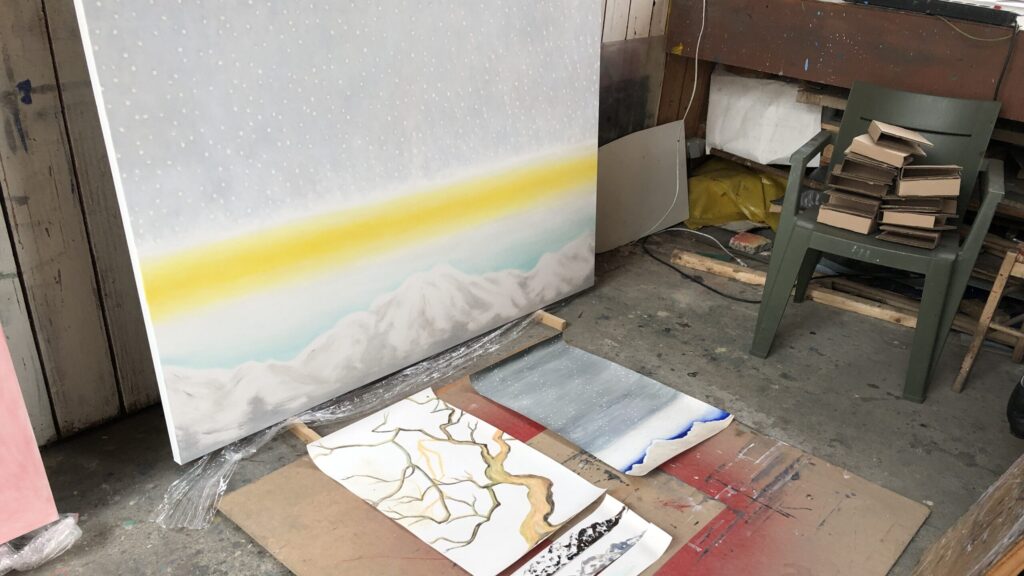
When artist Shigeru Hasegawa was invited for a residency at Zundert he specifically asked if he could stay longer than just the one month. Apart from the time he needs to adjust himself after the long journey from Japan. Although he is a quick painter, he could never finish the large paintings he had in mind. Shigeru literally started from zero because all the materials had to be bought here while the plan was still defining itself. The plan was actually a situation that emerged by finding himself at the other side of the world which made it possible to rediscover his Japanese roots in the art.
Can you tell me more of your arrival? Did you really come here without an idea what you would like to explore?
At first, I didn’t know what to do here. I came from Japan, so I took that with me. Now I am here surrounded by the influence of Vincent van Gogh. So, there are a lot of books here, to read, to look at the paintings of Vincent. The first days I painted some stupid realistic paintings that I threw away. Not something I want people to look at. But after that the plan came. Vincent was inspired by Japanese woodprints, to be specific the woodprints of Hiroshige. So, I brought the two of them together.
And how did you do that?
I made a large painting with snow based on the work Hiroshige. There are three woodprints made by Hiroshige that Vincent painted: the bridge, the plumtree and the figure of a woman. I started from that idea and work on it the other way around. I look at the prints of Hiroshige because of the paintings of Vincent. As a Japanese I try to bring Hiroshige and Vincent together, but I am a painter just like Vincent, I do not make prints, well just once when I was studying art.
The snow painting I made after the woodprints; it is a theme you see often. I am not usually a landscape artist, but here I used the Japanese and Dutch landscape tradition together. Dutch masters like Jan van Gooyen, Vermeer and Ruysdael always have a low horizon, so you see a big sky with a lot of clouds. I also put in the snow painting a very low horizon and combined this with a mountain at the bottom. In Japanese art a low horizon is rare. A mountain is often depicted in Japanese prints, but my mountains look a bit more western. So, I used this big sky painting just for snowflakes, I wanted to do something like this for a long time, to make a painting with a big sky. The snowflakes are actually not painted, but are white dots spared out. This is the same way that is used in block print. It took me about six hours to paint the large show painting. Sort of meditative.
Here in Zundert is the first time I try this. The yellow light in the horizon is something of Vincent. It is about combining different approaches of painting the landscape.
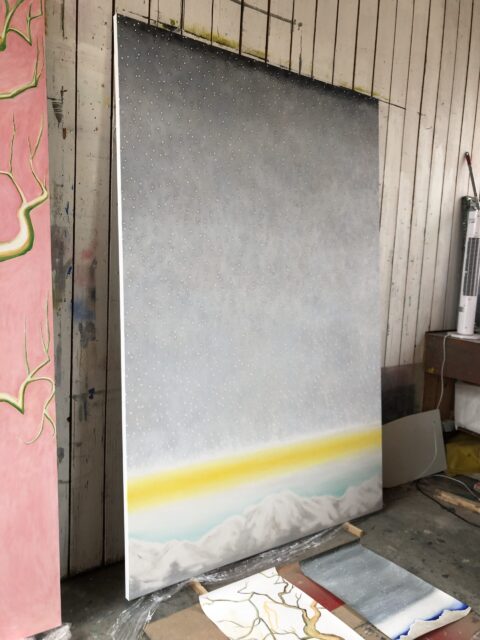
Photo Esther van Rosmalen
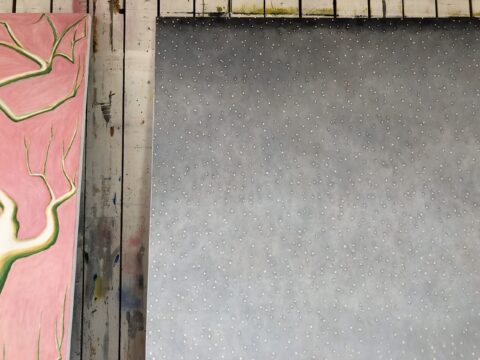
Photo Esther van Rosmalen
And you also depicted another theme, the tradition of Sakura if I am correct?
Yes, Sakura. The large canvas of the tree, and with a pink background, is based on the woodprint of the plumtree. Now it is a ritual in Japan to go to the cherry trees blossoming. The tradition is restored by a Western researcher that found out about the many sorts of cherry trees in Japan, that were kind of forgotten. That was around the 19th century. But before that there was a tradition to go visit the plumtrees when they blossom. Therefore, you see very often a plumtree in woodprints. I tried to paint this plumtree but I made the tree more abstract. I painted first some sketches with blossom, but that became to poetic, too much of a story, so I made the tree without the flowers.
Too sweet with the flowers. I wanted to make a more solid tree without the cliché.
So, you chose only to paint the branches instead of flowers?
Now the branches have a worn structure, to show movement. In other works of Hiroshige there is a tree with a branch in the form of a circle. This tree exists and is still to be found in Tokyo. The circle is made by humans, you know bonsai?
I do. Do you mean that bonsai is also applied at large trees?
Bonsai is to make a tree grow in a certain form. In my painting I also depicted a branch in a circle, as a quote of Hiroshige, but no flowers. Actually, I like this painting very much. The pink background is also from Hiroshige, it is the sort of colour he chose a lot. I tried to make a good combination with the bright green of the branches. I think it works.

Photo Esther van Rosmalen

Photo Esther van Rosmalen
The tree seems to float, why is that?
Japanese painting and woodprint usually do not use shadow, no perspective. The background is a space. It is not realistic. So yes, the tree floats. I used that flat feeling and changed it later with Western influence.
What is the Western influence?
When I was young, around the age of 18, I started with the Western way of painting. That was a category as there are more categories; there was for example also Japanese painting to learn. So, with me it is the other way around, Vincent was influenced by Japanese art because of the prints, but I was influenced by Western art. Being here I allowed myself to be influenced by traditional Japanese art.
When the Western influence came in Japan, people were so enthusiastic about it. Like there was now a train and electricity, but also art like oil painting and perspective by using shadow. Art became more realistic. Some artists choose to stick to the Japanese art they know, but a lot of artists choose for the Western approach. When Vincent looked at the Japanese prints, realism came into Japan. So strange and in a way also a pity because a lot of beautiful art is gone. Now the appreciation for the traditional art is changing, in Japan, but little by little. Slowly they realize we have to keep things.
And at what time or moment took this Western influence take place?
The first shock of Japan with Western culture was in the middle of the 19th century. After the second World War there was again a shock like that, but now with American culture and the Western influence became more part of society and traditional Japanese things disappeared. After this Japanese copy all sort of Western things. So, in art we always follow the Western genres but always 20 years later. Styles like Cubism, Surrealism, Minimalism. We have them all, but always 20 years later. We follow the styles of the Western art but we do not set a style.
And what is the style that is followed now?
Expressionism. But it is changing because of the internet. Styles are copied like Luc Tuymans, Marlene Dumas. Young artists follow their style and galleries like that. But there is some counteract, and that is animation. It is a key in modern Japanese art like for example used by Yoshitomo Nara. The animation is very good in Japan, like you know Studio Ghibli. Japanese architecture, film, and anime is well known. There is not a problem, but between that and art is a gap.

Photo Esther van Rosmalen
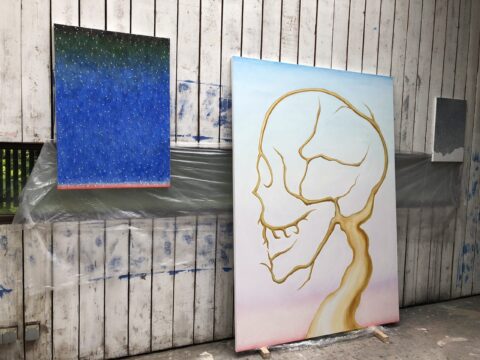
Photo Esther van Rosmalen
And is anime something you can relate to?
For me, I do not want to make a copy of Western art or copy manga and anime. I want to find ways to influence each other. The paintings that I made here, I will donate them all to the Van GoghHouse. For me it is about the experience of being here, to have the possibility for artistic research. To see things from a different perspective. Besides the woodprints of Hiroshige, there is also some other influence of Vincent in my paintings. The other painting with the tree is based on the form of a skull. Like Vincent painted skulls, but in a way outlined in tree branches.
It looks a bit surrealistic?
That is one of my favourite Western styles: Surrealism, like Giorgio de Chirico or Magritte. But the colours I used in the background are also based on the colours of the background of a woodprint.
Which is your favourite painting?
The green tree in pink, because all of them are based on Vincent, but this one is based on Hiroshige and Vincent in my own way of painting. The other are more based on an idea. This is less an idea and feels more like my own work. This is what I found here and something I like to use more. I made different things, but only this one I am satisfied with.
Esther van Rosmalen, April 2025
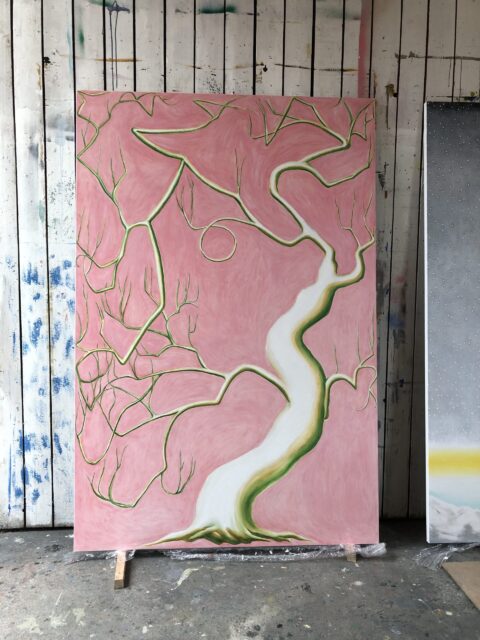
Photo Esther van Rosmalen
